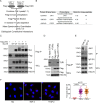Transforming Growth Factor-β (TGF-β) Directly Activates the JAK1-STAT3 Axis to Induce Hepatic Fibrosis in Coordination with the SMAD Pathway
- PMID: 28154170
- PMCID: PMC5354477
- DOI: 10.1074/jbc.M116.773085
Transforming Growth Factor-β (TGF-β) Directly Activates the JAK1-STAT3 Axis to Induce Hepatic Fibrosis in Coordination with the SMAD Pathway
Abstract
Transforming growth factor-β (TGF-β) signals through both SMAD and non-SMAD pathways to elicit a wide array of biological effects. Existing data have shown the association and coordination between STATs and SMADs in mediating TGF-β functions in hepatic cells, but it is not clear how STATs are activated under these circumstances. Here, we report that JAK1 is a constitutive TGFβRI binding protein and is absolutely required for phosphorylation of STATs in a SMAD-independent manner within minutes of TGF-β stimulation. Following the activation of SMADs, TGF-β also induces a second phase of STAT phosphorylation that requires SMADs, de novo protein synthesis, and contribution from JAK1. Our global gene expression profiling indicates that the non-SMAD JAK1/STAT pathway is essential for the expression of a subset of TGF-β target genes in hepatic stellate cells, and the cooperation between the JAK1-STAT3 and SMAD pathways is critical to the roles of TGF-β in liver fibrosis.
Keywords: Janus kinase (JAK); Liver fibrosis; SMAD transcription factor; STAT3; Smad3; hepatic stellate cell (HSC); transforming growth factor beta (TGF-B).
© 2017 by The American Society for Biochemistry and Molecular Biology, Inc.
Conflict of interest statement
The authors declare that they have no conflicts of interest with the contents of this article
Figures






Similar articles
-
Transforming growth factor-β (TGF-β)-mediated connective tissue growth factor (CTGF) expression in hepatic stellate cells requires Stat3 signaling activation.J Biol Chem. 2013 Oct 18;288(42):30708-30719. doi: 10.1074/jbc.M113.478685. Epub 2013 Sep 4. J Biol Chem. 2013. PMID: 24005672 Free PMC article. Clinical Trial.
-
Isorhamnetin attenuates liver fibrosis by inhibiting TGF-β/Smad signaling and relieving oxidative stress.Eur J Pharmacol. 2016 Jul 15;783:92-102. doi: 10.1016/j.ejphar.2016.04.042. Epub 2016 May 3. Eur J Pharmacol. 2016. PMID: 27151496
-
Bone morphogenetic protein-7 represses hepatic stellate cell activation and liver fibrosis via regulation of TGF-β/Smad signaling pathway.World J Gastroenterol. 2019 Aug 14;25(30):4222-4234. doi: 10.3748/wjg.v25.i30.4222. World J Gastroenterol. 2019. PMID: 31435175 Free PMC article.
-
Activation of Nrf2/AREs-mediated antioxidant signalling, and suppression of profibrotic TGF-β1/Smad3 pathway: a promising therapeutic strategy for hepatic fibrosis - A review.Life Sci. 2020 Sep 1;256:117909. doi: 10.1016/j.lfs.2020.117909. Epub 2020 Jun 5. Life Sci. 2020. PMID: 32512009 Review.
-
TGF-β/SMAD Pathway and Its Regulation in Hepatic Fibrosis.J Histochem Cytochem. 2016 Mar;64(3):157-67. doi: 10.1369/0022155415627681. Epub 2016 Jan 8. J Histochem Cytochem. 2016. PMID: 26747705 Free PMC article. Review.
Cited by
-
miR‑320a‑3P alleviates the epithelial‑mesenchymal transition of A549 cells by activation of STAT3/SMAD3 signaling in a pulmonary fibrosis model.Mol Med Rep. 2021 May;23(5):357. doi: 10.3892/mmr.2021.11996. Epub 2021 Mar 24. Mol Med Rep. 2021. PMID: 33760151 Free PMC article.
-
Phosphorylation of SMURF2 by ATM exerts a negative feedback control of DNA damage response.J Biol Chem. 2020 Dec 25;295(52):18485-18493. doi: 10.1074/jbc.RA120.014179. Epub 2020 Oct 23. J Biol Chem. 2020. PMID: 33097595 Free PMC article.
-
Tyrosine kinase inhibitor neratinib attenuates liver fibrosis by targeting activated hepatic stellate cells.Sci Rep. 2020 Sep 8;10(1):14756. doi: 10.1038/s41598-020-71688-2. Sci Rep. 2020. PMID: 32901093 Free PMC article.
-
JAK/STAT3 signaling in cardiac fibrosis: a promising therapeutic target.Front Pharmacol. 2024 Mar 1;15:1336102. doi: 10.3389/fphar.2024.1336102. eCollection 2024. Front Pharmacol. 2024. PMID: 38495094 Free PMC article. Review.
-
Mesenchymal stroma/stem-like cells of GARP knockdown inhibits cell proliferation and invasion of mouse colon cancer cells (MC38) through exosomes.J Cell Mol Med. 2020 Dec;24(23):13984-13990. doi: 10.1111/jcmm.16008. Epub 2020 Nov 5. J Cell Mol Med. 2020. PMID: 33155413 Free PMC article.
References
-
- Fabregat I., Moreno-Càceres J., Sánchez A., Dooley S., Dewidar B., Giannelli G., Ten Dijke P., and IT-LIVER Consortium (2016) TGF-β signalling and liver disease. FEBS J. 283, 2219–2232 - PubMed
Publication types
MeSH terms
Substances
LinkOut - more resources
Full Text Sources
Other Literature Sources
Medical
Molecular Biology Databases
Research Materials
Miscellaneous

